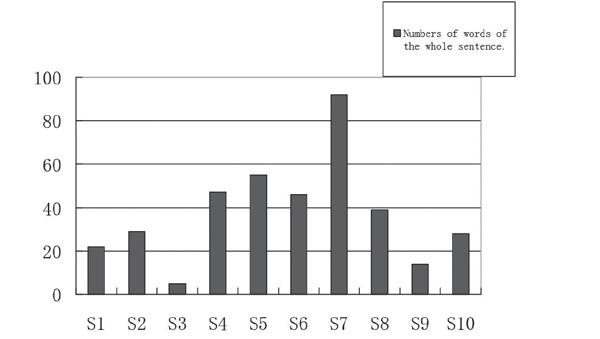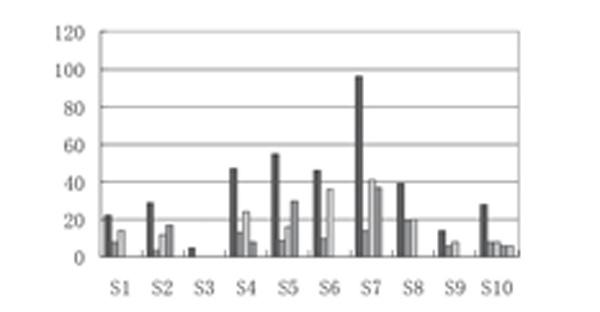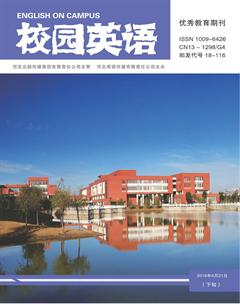Appreciationof“August”byCharlesDickensfromthe
谢滔滔



【Abstract】This paper is going to appreciate “August” by Charles Dickens from the angle of over-regularity which is part of Foregrounding theory.
【Key words】Over-regularity; Phonological Level; Syntactical Level
1. Over-regularity
Over-regularity can be acquired on two levels: phonological and syntactical. On the phonological level, alliteration, assonance and consonance are the most commonly used in foregrounding, while on the syntactical level, parallelism and para-diastole are often used. The following part, the author is going to appreciate Charles Dickens “August” from these two levels.
1.1 Phonological Level
Sentence 4 (S4)
In S4, phonological features can be seen in many places, for example, alliteration in “field” “flower” “fade” “from” and “sky” “sweet-smelling” “snow”, assonance in “green” “sweet” “bleak” and “sky” “ice” and consonance in “disappear” “clear” and “winds” “minds”. But “winds” and “minds” belongs more to eye rhyme.
S5
In S5, alliteration is also used in “bent” “beneath” and “branch”; consonance in “rich” “which” and “branch”.
1.2. Syntactical Level
S3
Para-diastole is the use of euphemism to soften the force of naming a vice or a virtue. It is often used ironically. In biblical studies it has come to mean the repetition of disjunctive words in a list. This sentence could be rewritten as “August hasnt such advantage.” and “August has disadvantage.” But this paragraph is talking about the beautiful and pleasant factors of August. So the author separate August from negative elements as far as possible. So para-diastole is used as a means of foregrounding.
S4
In S4, there are two adverbial clause initiated with “when” and create a parallelism. And “has faded from our minds as completely as they have disappeared from the earth” is also a symmetrical structure.
To change the frequency of some language phenomenon is also a kind of over-regularity. In this text, there are ten sentences, a lot of which are long and complicate, only S3 and S9 are comparatively short and simpler. S7 is the longest and most complicated one. The changing of the length of the sentences can create a interesting musical rhythm.
Graph 1:
The Y-axis represents the whole words number of each sentence, while the X-axis refers to the serial numbers of the sentences.
When each sentence is broken into parts according to the clauses of the sentences, another graph can be formed.
Graph 2:
The black columns represent the total words numbers of each sentence, which is the same as Graph1. The columns in lighter colors refer to the words numbers of clauses in each sentence.
Many sentences in this text are compound or compound complex sentences. In this graph, the clauses in those sentences are divided.
S1-S6 describes scenery of August. The rhythms are slow and smooth. When the coach appears, described in S7, the sentence becomes very long and complicate, and takes a lot of time and energy to finish reading it. It seems that it is the coach that breaks these general rhythms. Besides, the coach acts as if it is a zipper. It zippers the whole scenes of working people open and present them to the reader in a breath taking way. When the coach turns a corner (S9), every thing returns to normal, so it is with the rhythm. S10 is consisted with four simple clauses with 8 words in the first two clauses and 6 in the rests.
From S4, “ It comes when we remember nothing but clear skies, green fields and sweet-smelling flowers /——when the recollection of snow, and ice, and bleak winds, has faded from our minds as completely as they have disappeared from the earth——/and yet what a pleasant time it is!” , we came to an interesting graph as follow:
Graph3:
To sum up, the whole text sounds like a piece of music. And the musical rhythms are created by the lengths of the sentences and clauses in them. Using of punctuation and foregrounding are to be thanked for creating this kind of effects.
2. Conclusion
Over-regulating is part of Foregrounding theory, which has been studied by scholars for years. But most scholars see foregrounding from the aspect of linguistic. Few combine foregrounding theory with translation. Over-regulating offers an different and interesting way to appreciate and understand the source text in translation. It can also function as a new standard to evaluate the target text.
References:
[1]Halliday,M.A.K.Explorations in the Functions of Language[M].London:Edward Arnold,1973:103-143.
[2]Mukarovsky,J.Standard language and Poetic language[C].In:Garvin,P.L.ed.A Prague School Reader on Esthetics,Literary and Style.Washington D.C.:Geogetown42 University Press,1964:17-30.
[3]Zhu Gang.Twenties Century Western Critical Theories[M].ed.Shanghai:Foreign Language Education Press,2003:14.
[4]陈德彰.英汉翻译入门[M].北京:外语教学与研究出版社,2005.
[5]方平译.呼啸山庄[M].上海:上海译文出版社,1993:38.
[6]秦秀白.简明英语文体学[M].长沙:湖南教育出版社,1983.
[7]王佐良,丁往道(主编).英语文体学引论[M].北京:外语教学与研究出版社,1987.
[8]徐艳萍,杨跃.谈卡明斯诗歌中的变异和突出[J].西安外国语学院学报.2005.(1).
[9]叶子南.高级英汉翻译理论与实践[M].北京:清华大学出版社.2001.
[10]http://en.wikipedia.org/wiki/Charles_Dickens 2010.5.16.
[11]http://en.wikipedia.org/wiki/Paradiastole 2010.5.16.

